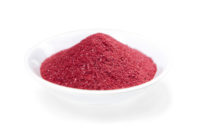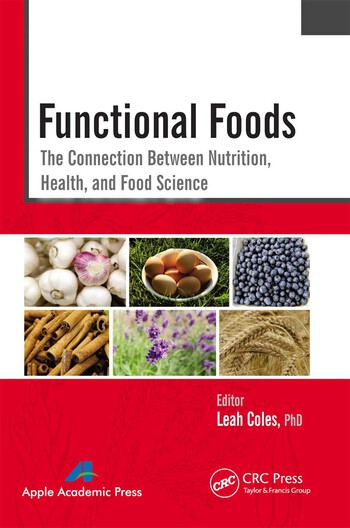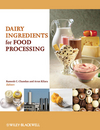Antioxidants: New Food Science, Ingredients
Prepared Foods’ R&D Application Seminars recently explored antioxidants. Presenters discussed some of the pioneering technology in this field, as well as a look at five “orphan ingredients” with strong antioxidant capacity.
Effects of Drying Methods on Vitamin C Content
Details of a unique, infrared drying method by Vivid Harvest that preserves the vitamin and antioxidant content and capacity of fruits and vegetables was presented by Rodger Jonas, director of national sales, PL Thomas Inc., in his Prepared Foods’ R&D Application Seminar titled “Effects of Drying Methods on Vitamin C Content.”
Jonas discussed the pioneering, patented drying technology called Radiant Zone Drying (RZD). To preserve delicate nutraceuticals, the process uses infrared energy that targets water molecules without disturbing the antioxidants, phytonutrients, vitamins, minerals or enzymes in the fruit. The system handles fruits and vegetables in most forms, from thin-film liquids (juices, purees, slurries) up to pulps and pieces, and subjects them to a low, controlled temperature process that takes only minutes to dry -- typically less than 10 minutes.
In addition to nutrient and phytochemical antioxidant retention, the value, flavor, color and other organoleptic characteristics are preserved. The resultant powders, when used in formulations, provide the exemplary taste, smell and appearance of true fruit. The system allows for the reduction of carriers and drying aids that also could impact nutraceutical performance. Flowability, dispersibility and solubility are excellent, along with bulk density. Plus, the ultra-low-water activity assures the active compounds have an increased shelflife.
For processors striving to help Americans meet USDA requirements of at least 2 cups of fruits and 2 ½-3 cups vegetables per day as natural sources of vitamins, minerals and phytochemicals, such as antioxidants, Jonas noted small amounts of RZD fruit or vegetable powders can allow processors to incorporate the equivalent of a cup of produce in single-serving size products. For example, 14g of RZD blueberries, 11g of RZD strawberries, 6g of RZD kale and only 3g RZD spinach all equal a cup of their respective ingredient in fresh format.
Jonas pointed to research studies that have shown resulting high-quality produce powders from the RZD process exhibit no statistically significant loss of vitamin C. He also cited a study published in 2010 in the Journal of Agriculture and Food Chemistry. That study demonstrated that total antioxidant capacity of blueberry products sustained no statistically significant loss of total antioxidant. As an example, Jonas showed that an RZD carrot extract contains 100 times higher content of the powerful water-soluble antioxidant carotene than whole carrots.
“Effects of Drying Methods on Vitamin C Content,” Rodger Jonas, Director of National Sales, PL Thomas Inc., 973-984-0900, www.plthomas.com, rodger@plthomas.com
-- Summary by David Feder, RD, Executive Editor, Technical
Orphans of the Storm: Five (+) Nutraceuticals
An overview of so-called “orphan ingredients,” including several with powerful antioxidant capacity, was presented by David Feder, RD, executive editor, technical, for Prepared Foods magazine. The presentation, titled “Orphans of the Storm,” was given at the Prepared Foods’ R&D Applications Seminar in Chicago.
The first of the nutraceutical “orphans” with antioxidant ability discussed by Feder was coenzyme Q-10 (CoQ10). Although the compound is best known for its primary role of creating from food the energy needed to run every cell in the body, CoQ10 also is a highly effective and powerful antioxidant, more so than most antioxidants from botanical sources.
Unfortunately, the body’s ability to generate CoQ10 plummets after about age 35. CoQ10’s antioxidant capacity is such that it has been suggested as being beneficial for preventing or mitigating symptoms of such diseases and dysfunctions as neurogenerative disease (e.g., Parkinson’s), cancer and cardiovascular disease.
Feder noted that naturally rich sources of CoQ10 are not prevalent in the modern American diet, being primarily heart, liver and muscle meats, although seafood and some oils also provide the coenzyme. Fortification with CoQ10 traditionally has been hampered because it’s a large, fat-soluble molecule and difficult to absorb.
Microencapsulation has greatly expanded potential targets for CoQ10 fortification. Starch-based hydrophilic coatings allow CoQ10 to be incorporated into stable solutions/dispersions.
Small CoQ10 beadlets coated with starch-based granules can be dispersed into a water-soluble fish gelatin matrix. Cyclodextrin, starch derivatives in the shape of a ring with a proven record of safety in the food industry, also are effective.
Another high-antioxidant orphan ingredient class discussed by Feder is the myconutritionals— ingredients derived from mushrooms and other fungi. Mushrooms and their extracts have been used as anti-cancer agents in traditional medicine for centuries. However, a wave of scientific research has been bearing this out.
According to Seema Patel and Arun Goyal, lead researchers reporting in the review “Recent developments in mushrooms as anti-cancer therapeutics” published March 2012, in the journal 3 Biotech, “Mushrooms have emerged as wonderful source of nutraceuticals, antioxidants, anti-cancer, prebiotic, immunomodulating, anti-inflammatory, cardiovascular, anti-microbial and anti-diabetic [compounds].”
A third ingredient class with antioxidant ability presented included microalgae. Most microalgae act as miniature living factories of a wealth of important nutraceutical compounds, including the antioxidant mineral selenium, carotenoids and other antioxidants. With 800,000 or more microalgal species, the versatility of this source is nearly infinite.
Feder touched on one of the biggest trending ingredients in microalgal antioxidants: astaxanthin. Astaxanthin has been used as a topical antioxidant for protection against UV damage to skin cells, but it also functions as a highly effective beauty-from-within ingredient.
Having recently attained GRAS approval, astaxanthin has begun to appear in some beverage products and bars, but still presents a wide-open field for processors to include in formulations for health and protection against diseases and dysfunctions related to the damage and inflammation resulting from the reactive oxygen species that assault the body through environmental pollutants and insults.
“Orphans of the Storm: Five (+) Super Nutraceuticals You’ve Been Missing,” David Feder, RD, Executive Editor, Technical, BNP Media Inc., 847-405-4081, www.preparedfoods.com, federd@bnpmedia.com
Looking for a reprint of this article?
From high-res PDFs to custom plaques, order your copy today!







